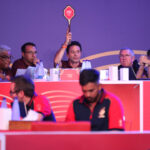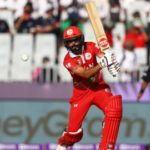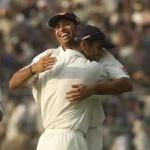
Records are meant to be broken, said a theorist once. Cricketing records are being made each day with the advancement in the game and change in protocols. Players are getting adapted to the new generation of cricket and it’s getting better and better. But on the other hand, there have been many records that were missed by inches. So today in this article we will speak about those records which were almost made but remained undone.
The first record here in contention is here is that of Jack Hobbs who ended his first-class career with a mind-boggling 199 centuries. Jack was one of the greatest batsmen of all time with close to 62,000 runs at a healthy average of 50.70. He had a major career break of 6 years owing to World War 1 but that did not stop him from achieving greatness as he returned to the field once again post the world war massacre and has most centuries in his forties. He also has a record of being the oldest to score a first-class century at the age of 46. When he retired from first-class cricket he had 197 centuries under his belt. Interestingly when he hung up his boots, a few years after his retirement, a couple of hundreds which he had scored for Vizianagaram’s XI in the 1930-31 season were added to his first-class century count taking it to 199 which was just one shy of a record 200 centuries.
The second record in contention is of the GOAT, Don Bradman. This Aussie legend missed a great record by a whisker when his career ended with his test average of 99.94 which could have easily been a perfect 100. He had amassed over 6000 test runs over the years with 29 centuries and used to bat the other team out with his ferocious batting skills. Before stepping out to bat for his last innings he had a rest average of 101.39 and he just had to score a mere 4 runs to finish his legendary career with a memorable average of a perfect 100 and also could have taken his overall tally to 7000 runs but then came the biggest twist and a shock to cricket enthusiasts around the globe. However, as fate would have it, he was deceived by a googly from Eric Holli and dismissed on the second ball for a duck and that was the final bell on his cricketing career with an everlasting average of 99.94.
The next record in contention is of English pacer Sydney Barnes. He was considered as one of the greatest bowlers of all time due to his amazing line and lengths and some sheer pace and the ability to get wickets at will. All this came at a time in a cricketing circle when there wasn’t a two-ball rule and bowlers had to work on the same old bowl from time and time. In just 27 Tests, he picked up a whopping 189 wickets at an excellent average of 16.43 and a measly economy rate of 2.36 with 24 ten-wicket hauls. In the 1913 South Africa series he was in the form of his life and was picking up wickets like anything and had already 49 scalps under his belt and almost 198 total career wicket count. However, he opted out of the final Test when he was informed by the authorities that his wife’s accommodation would not be sponsored thus missing out on a rare feat of becoming the first bowler to take 50 wickets in a Test series and 200 wickets overall.
The next record up in contention is Hanif Mohammad’s 499 in the Quaid-e-Azam trophy 1959. Hanif was easily one of Pakistan’s gold batsmen at that time with an amazing stance, on-point footwork, and magical timing with a special on the drive. He also had a rare record under his name of batting for the longest time in a test match as his innings lasted for 970 whole minutes. In the test against Bahawalpur, a strong Karachi batting line-up came into bat and after a slow start things came into control under the batting of Hanif. Hanif ended the day on a score of 255* and his elder brother reminded him of Don Bradman’s record of 452* against Queensland urging Hanif to bat on and not let any string lose. The next day he came into bat once again and went in thrashing the bowlers to move on to a score of 496 breaking Don Bradman’s record. But then came the twist as the scoreboard misread his total as 498 when it was 496. Realizing that there were just two balls left in the day and that his brother may declare overnight, he guided the ball past point off the next delivery and got run out in an attempt to complete a cheeky second run. Later he realized that he had missed a rare feat of scoring 500 runs by a run and was almost inconsolable.
Next up is former South African skipper Hanse Kronje’s record of 99 ODI wins as captain. Hanse was the captain of the Proteas from 1994 to 2000 and was widely regarded as one of the best captains going around in his time. He was quite an influential figure in the South African team especially after the Apartheid era. Hanse had led the team to 99 ODI victories in the 138 matches he had captained with an amazing win percentage of 73.70 and was only one win away from becoming the only player after Allan Border to guide his team to a hundred ODI victories. But luck has its ways and the match-fixing scandal bought an end to his prosperous career and unfortunately it stooped him for reaching the benchmark of a hundred ODI wins forever.
Next up in contention in the little master Sachin Tendulkar’s record of 49 test centuries. The man the legend of the game Sachin has set a huge benchmark of a hundred international hundreds which is 49 ODI centuries and 51 test centuries combined. Sachin was in a magnificent form during the 2011 cricket World cup and in the purplest patches of his cricketing career. Pot the world cup he had 99 centuries under his belt and 48 ODI centuries when he made the 49tha against Bangladesh in 2013 and became the first-ever to reach the benchmark. But little did he know that he was never gonna break the 50 ODI century record even after coming so close as there was a sudden drip in his form so he hung up his boots in ODI cricket and focussed only on tests from where he announced his retirement later too. Thus the 50 ODI hundreds record is one which he missed by a whisker.
Next up is another close record miss by former Proteas Wicketkeeper Mark Boucher. Mark is often considered as the best man behind the stumps owing to his quick movement and amazing presence of mind. Mark had a stellar record of 999 international dismissals to his name as a wicket-keeper before the 2012 tour of England. He was eyeing a historic achievement of becoming the first wicket-keeper to effect a thousand stumpings in international cricket. However in a county match against Somerset when he was keeping without a helmet on facing Imran Tahir deliveries, one of which hit the stumps and the bail hit Boucher on his left eye engrossing him into severe pain and he had to leave the field immediately. Test results later showed that his retina was safe but he had lost his vision partially this forcing him to hang his boots on from International cricket thus leaving an almost created record as undone.
Next up in contention is the missed record of dashing Indian opener Virender Sehwag. He was one of those cricketers who modernized test cricket batting by going for his shots, playing naturally, and showing his hitting prowess. In late 2009 India had hosted Sri Lanka for a Test series at home. Sehwag was in the form of his life scoring runs like anything. In the first test Sri Lanka had scored 360 in their first innings and Viru started hitting from the word go. At stumps on the day, two Sehwag was batting along with Rahul Dravid on 284 not out. When he came out to bat the next day and just when it looked like he would get to the landmark very soon, almost against the run of play, he was dismissed by Muttiah Muralitharan, which meant that he fell short of the record by a mere 7 runs. Thus adding his name to the list of people who missed great records by just a whisker.
Next up is a record is by yet another Indian opening batsman and the heir to Sehwag’s throne, Rohit Sharma. Rohit is a gifted opener, a classy batsman, and a master of the pull shot. Against Sri Lanka in November 2014, Rohit became the first cricketer to score two double hundreds in ODI cricket. He scored 264 runs off just 173 balls including a whopping 33 fours and 9 sixes. Almost 80% of his runs during his innings of 264 came in the form of boundaries. That shoes the domination of Rohit Sharma’s hitting prowess. On the last ball of the innings he was unbeaten on 264 and just four runs shy off equalling Alistair Brown’s record of the highest List A score of 268 when he hit the ball towards long-on and got caught on the rope this denying Rohit of yet another record




